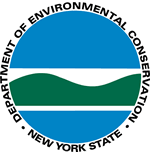 Lake sturgeon will again be stocked in North Country waters as part of a restoration program for this threatened fish species, according to Judy Drabicki, Region 6 Director for the New York State Department of Environmental Conservation (DEC). This restoration effort is made possible in collaboration with the U.S. Fish & Wildlife Service (USFWS), the St. Regis Mohawk Tribe (SRMT), the New York Power Authority (NYPA) and the U.S. Geological Survey (USGS).
Lake sturgeon will again be stocked in North Country waters as part of a restoration program for this threatened fish species, according to Judy Drabicki, Region 6 Director for the New York State Department of Environmental Conservation (DEC). This restoration effort is made possible in collaboration with the U.S. Fish & Wildlife Service (USFWS), the St. Regis Mohawk Tribe (SRMT), the New York Power Authority (NYPA) and the U.S. Geological Survey (USGS).
On October 22, more than 10,000 fingerlings (four month old, 5- to 8-inch long fish) will be released into the St. Lawrence River and its tributaries. Approximately 7,000 lake sturgeon will be stocked in the St. Lawrence River in Ogdensburg at the Greenbelt boat launch off Riverside Ave. The Salmon River, St. Regis River, and Raquette River will receive a portion of the remaining fingerlings, continuing the St. Lawrence River tributary stocking program, which has been ongoing for several years.
The lake sturgeon is one of New York’s largest freshwater fish.
Under the restoration program, eggs were collected from mature fish at the New York Power Authority St Lawrence River Power Dam in Massena this spring. After fertilizing, the eggs were transported to the USFWS fish hatchery in Genoa, Wisconsin, and the hatched fish were nourished until they were large enough to be stocked back into the wild. Some of the fertilized eggs were taken to the DEC Oneida Hatchery for hatching, raising and release into other NY waters.
‘This magnificent fish species was classified as threatened in New York State nearly 40 years ago, but stocking continues to help reverse population declines that occurred earlier this century,” Drabicki said. “Previous stocking efforts in tributaries like these in St. Lawrence County have demonstrated success, with dozens of sturgeon ranging up to 48 inches being observed and some having reached maturity, when they are ready to spawn.”
 David Stilwell of the USFWS said “One of the Service’s goals is to work towards fully functional and sustainable landscapes. This multi-agency effort to reintroduce lake sturgeon to New York rivers brings us one step closer to restoring the natural heritage of New York waterways. We look forward to working together in partnership on future projects in the St. Lawrence River tributaries.”
David Stilwell of the USFWS said “One of the Service’s goals is to work towards fully functional and sustainable landscapes. This multi-agency effort to reintroduce lake sturgeon to New York rivers brings us one step closer to restoring the natural heritage of New York waterways. We look forward to working together in partnership on future projects in the St. Lawrence River tributaries.”
Lake sturgeon once flourished in waters along New York’s northern border and provided large commercial harvests near Buffalo. In 1885, harvests totaled 1,800 tons. Prior to the decline in the sturgeon populating, these large fish inhabited all areas of New York’s border waters on the west, north and northeast regions of the state, including Lake Erie, the Niagara River, Lake Ontario, the St. Lawrence River, Lake Champlain and in several St. Lawrence River tributaries up to 60 miles upstream.
Activities to increase lake sturgeon populations include: protection from harvest, hatchery rearing, planning, habitat improvement, stocking of fingerlings, and outreach and education. In order to cover all these activities, DEC is cooperating with our federal partners and the SRMT and NYPA. USFWS and USGS focus on raising the small fish in hatcheries and evaluating their survival and growth toward maturity then everyone is involved in communicating to the public about our efforts and how to protect the fish. The USFWS – New York Field Office helps support the lake sturgeon restoration program through funding provided from the Fish Enhancement, Mitigation, and Research Fund, a settlement reached with the New York Power Authority for the relicensing of the St. Lawrence Power Project.
The additional sturgeon reared at the DEC hatchery at Oneida Lake were stocked in the Genesee River downstream of Rochester and into Cayuga Lake in early October.
Hatchery fingerlings are produced for bodies of water chosen as having the best prospects for restoration. One of the signs of program success has been experienced with mature fish being seen in spawning locations in Oneida Lake and the Oswegatchie River, when they are ready to spawn. In addition, small fish have been collected from Oneida Lake that were naturally spawned.
Inquiries about this threatened fish restoration program and other similar projects can be directed to DEC, Bureau of Fisheries in Watertown, at (315) 785-2263. Additional information on lake sturgeon can be found on DEC’s website at: Lake Sturgeon Fact Sheet.







No Comments so far ↓
There are no comments yet...